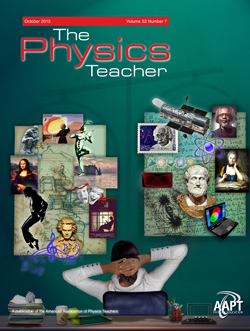 A Celebration of the Art, Craft, and Science of Physics Teaching
A Celebration of the Art, Craft, and Science of Physics Teaching
Articles from The Physics Teacher, 2015-2016
The cover image (at left) shows a physics teacher contemplating the balance of some of her favorite images from art and science. Which of these images can your students identify?
Introduction
Teaching: Art, craft, science? Yes!, Gary White DOI: 10.1119/1.4930999
Harmony and Higgs – Palette and Particle, Jack Hehn and Gary White DOI: 10.1119/1.49893083
Articles
A Course Connecting Astronomy to Art, History, and Literature, Don Olson DOI: 10.1119/1.4931004
Active Learning Strategies for Introductory Light and Optics, David R. Sokoloff DOI: 10.1119/1.4937966
Bringing (Century-Old) Technology into the Classroom, Part I: Teaching Mechanics and Thermodynamics with Antiques, John W. Jewett Jr. DOI: 10.1119/1.4931013
Bringing (Century-Old) Technology into the Classroom, Part II: Teaching Vibrations and Waves, Electricity and Magnetism, and Optics with Antiques, John W. Jewett Jr. DOI: 10.1119/1.4937967
Color Addition and Subtraction Apps, Frances Ruiz and Michael J. Ruiz DOI: 10.1119/1.4931012
Commedia dell'Arte as a Metaphor for the Art of Teaching, Robert A. Morse DOI: 10.1119/1.4931002
Defining and Developing “Critical Thinking” Through Devising and Testing Multiple Explanations of the Same Phenomenon, Eugenia Etkina and Gorazd Planinšič DOI: 10.1119/1.4931014
Learning from Mistakes: The Effect of Students' Written Self-Diagnoses on Subsequent Problem Solving Andrew Mason, Edit Yerushalmi, Elisheva Cohen and Chandralekha Singh DOI: 10.1119/1.4940171
Making Inexpensive 3-D Models, Harry Manos DOI: 10.1119/1.4942135
Modern Kaleidophones, John A. Daffron and Thomas B. Greenslade Jr. DOI: 10.1119/1.4931007
My Favorite Exam Question, Dan Styer DOI: 10.1119/1.4935763
The Physlet Approach to Simulation Design, Wolfgang Christian, Mario Belloni, Francisco Esquembre, Bruce A. Mason, Lyle Barbato and Matt Riggsbee DOI: 10.1119/1.4931011
Re-Cycling, Robert W. Brown and Corbin E. Covault DOI: 10.1119/1.4933146
Respecting Our Students, Andy Gavrin DOI: 10.1119/1.4931009
Sparking Curiosity: How Do You Know What Your Students Are Thinking?, Wendy K. Adams and Courtney Willis DOI: 10.1119/1.4933147
Some Surprising Introductory Physics Facts and Numbers, A. James Mallmann DOI: 10.1119/1.4944361
Teaching and Learning Physics: Performance Art Evoking Insight, Wilfried Sommer DOI: 10.1119/1.4935762
Teaching Critical Thinking: Sense-Making, Explanations, Language, and Habits, David Maloney DOI: 10.1119/1.4931008
Teaching the Delightful Laws of Physics in a Survey Course, Paul G. Hewitt DOI: 10.1119/1.4931003
Teaching Physics with Music, Gordon P. Ramsey DOI: 10.1119/1.4931010
What We Don't Understand, We Explain to Each Other, David Pines DOI: 10.1119/1.4935761
Whiteboarding: A Tool for Moving Classroom Discourse from Answer-Making to Sense-Making, Colleen Megowan-Romanowicz DOI: 10.1119/1.4940170
Workshop Physics and Related Curricula: A 25-Year History of Collaborative Learning Enhanced by Computer Tools for Observation and Analysis, Priscilla W. Laws, Maxine C. Willis and David R. Sokoloff DOI: 10.1119/1.4931006
Additional Features
The importance of evidence in science, John L. Roeder DOI: 10.1119/1.4933138
In Tune, Paul Hewitt DOI: 10.1119/1.4931001
The language of the arrows, Joe Heafner DOI: 10.1119/1.4931020
Pythagoras's biggest disappointment, Ken Ford DOI: 10.1119/1.4937955
Reflections from the classroom, Ken Rideout DOI: 10.1119/1.4931000
The sound of church bells: Tracking down the secret of a traditional arts and crafts trade, Patrik Vogt, Lutz Kasper and Jan-Philipp Burde DOI: 10.1119/1.4931015
Using artistic drawings to create physics problems, Gorazd Planinšič DOI: 10.1119/1.4931019
Whiteboarding: The art and science of teaching physics via discourse, Dan MacIsaac DOI: 10.1119/1.4931022

